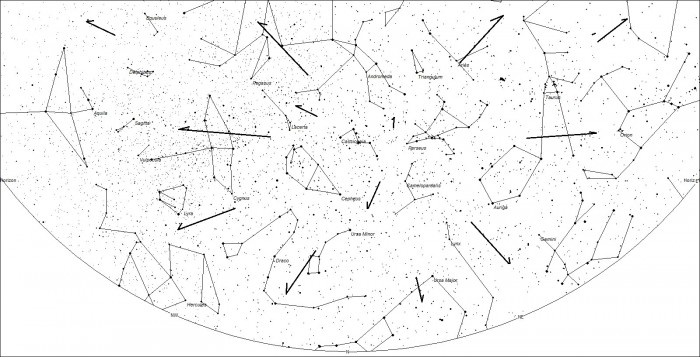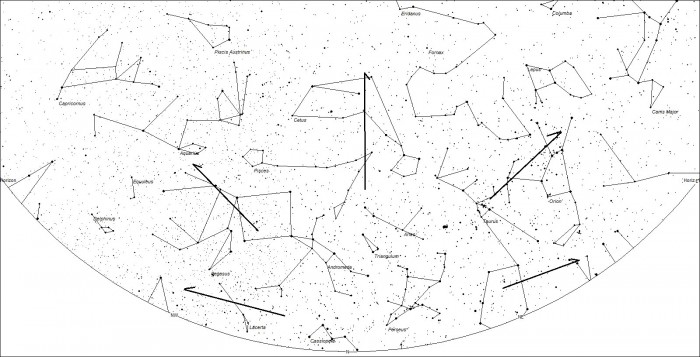Normal
0
false
false
false
EN-US
X-NONE
X-NONE
MicrosoftInternetExplorer4
st1\:*{behavior:url(#ieooui) }
/* Style Definitions */
table.MsoNormalTable
{mso-style-name:”Table Normal”;
mso-tstyle-rowband-size:0;
mso-tstyle-colband-size:0;
mso-style-noshow:yes;
mso-style-priority:99;
mso-style-qformat:yes;
mso-style-parent:””;
mso-padding-alt:0in 5.4pt 0in 5.4pt;
mso-para-margin:0in;
mso-para-margin-bottom:.0001pt;
mso-pagination:widow-orphan;
font-size:11.0pt;
font-family:”Calibri”,”sans-serif”;
mso-ascii-font-family:Calibri;
mso-ascii-theme-font:minor-latin;
mso-fareast-font-family:”Times New Roman”;
mso-fareast-theme-font:minor-fareast;
mso-hansi-font-family:Calibri;
mso-hansi-theme-font:minor-latin;
mso-bidi-font-family:”Times New Roman”;
mso-bidi-theme-font:minor-bidi;}
The Persesids are particles released from comet 109P/Swift–Tuttle during its numerous returns to the inner solar system. They are called Perseids since the radiant (the area of the sky where the meteors seem to originate) is located near the prominent constellation of Perseus the hero when at maximum activity. A great majority of these particles are tiny bits of rock and ice with the consistency of ash. They are only visible because of the tremendous velocity (38 miles/sec) as they strike the upper atmosphere. No Perseid meteor is known to have survived intact to the surface of the Earth as they are too fragile to survive their plunge through the atmosphere.
The Earth encounters Perseid meteors from July 13 through August 26 each year. Most of the Perseid activity is seen during the week centered on August 12. This is when the Earth passes closest to the orbit of the Perseid meteors. The greatest difference one year from the next is usually whether the moon is present while the Perseid radiant lies high in the sky during the early morning hours. If the moon is near full or a waning gibbous phase then the bright moonlight will obscure all but the brightest meteors. Most Perseid meteors are faint, therefore moonlight or local sources of terrestrial lights will greatly affect the number of meteor observed.
Luckily in 2013, at maximum activity on August 12, the moon will be a waxing crescent and will set near 2200 (10pm) local daylight time for locations at mid-northern latitudes. This will allow a good look at the show as the Perseid radiant is best placed high in the northeastern sky during the early morning hours
During the weekend of August 10/11, Perseid meteors will be visible near a rate of 20-40 per hour, depending on the time of night and your viewing conditions. On Monday morning August 12, the maximum rates should be near 60 per hour for observers under dark and transparent skies. If your skies are hazy then perhaps 40 per hour may be visible. If viewing from urban skies then expect to see no more than 20 Perseids per hour. By the morning of August 13, rates will have fallen by 50% to near 30 per hour. By the 14th rates will be near 15 per hour and again falling by near 50% each night.
While Perseid meteors can be seen all night long from most locations in the northern hemisphere, the radiant lies so low in the northern sky during the evening hours that only 3-5 meteors are visible per hour. If this is the only time you can watch it may be worth it as Perseids seen during the evening skim the upper atmosphere and are unusually long and long-lasting. If you can watch after midnight then I would suggest waiting until then as the Perseids will be far more numerous.
Perseid meteors can be seen in all parts of the sky. One can tell they are Perseids as their paths will all lead back to the constellation of Perseus. If it doesn’t then you have just witnessed one of the ten or so random (sporadic) meteors that are visible each hour during the morning hours. There are also minor showers active this time of the year from the constellations of Capricornus and Aquarius which will add a few meteors to the scene each hour. It would be best to view toward the darkest available direction. Do not look straight up, rather look halfway up in the sky to see the most meteor activity. The thickest slice of atmosphere lies near the horizon therefore looking straight up is looking through the thinnest slice and the least amount of activity. If one looks toward the horizon then too much of one’s field of view is wasted on the ground so the best compromise is looking half-way up.
For those located south of the equator, the Perseids are strictly a post midnight affair, as the radiant does not clear the horizon until the morning hours. For those located south of 35 degrees south latitude, the Perseids are not visible at all as the radiant never clears the northern horizon. So those situated near 30 degrees north latitude probably enjoy the best combination of high radiant altitude and long nights in which to enjoy the display.
The best Perseid activity, no matter the date or location, is usually seen during the last hour before the start of morning twilight, when Perseus lies highest above the horizon in a dark sky. This is usually between the hours of 0400 and 0500 local daylight time for most of us. While gazing high into the sky, one must be comfortable in order to avoid neck strains and fatigue. A folding lounge chair is the perfect solution. It is easily portable and comfortable. Be sure to also have a blanket or sleeping bag too, even if temperatures seem balmy. It’s surprising how the inactive body can become chilled even though the air temperatures seem warm.
The Earth is predicted to pass closest to the core of the Perseid meteors near 1900 Universal Time on August 12. This timing favors eastern Asia. The morning of August 12 will be the best time to see Perseid activity from North America. If that morning is cloudy the mornings of the 11th and 13th will also offer good activity.
The characteristic Perseid is a bright white or yellow meteor lasting less than a half second. The brighter meteors usually leave a persistent train or “smoke trail” that lasts a second or two after the meteor has vanished. This is not really smoke at all but rather ionized gas created by the meteor passing through the atmosphere at tremendous velocities.
One of the best times to try and photograph meteors is during the Perseid meteor shower. All you need is a camera capable of exposures lasting one minute or longer. Simply aim the camera high enough to clear the horizon and set the focus to infinity. Try to center the camera 30-60 degrees from the radiant so that the meteors are long enough to be easily seen on your photograph. Meteors appearing near the radiant will appear shorter as they are traveling in a direction toward you. It is also advisable to use the fastest film/ ISO setting possible to increase the sensitivity of you camera. Meteors will appear as straight streaks overlapping the curved trails created by the stars moving through the field of view. The length of the star trails will depend on the length of your exposure and the direction you point the camera. Pointing your camera northward will decrease the length of the star trails. Some photographers eliminate the stars trailing by mounting their cameras on motor driven mounts. With this setup the stars remain as pinpoints while meteors are obvious streaks.
While most folks are casual observers of meteor activity, it is also enjoyable and scientifically useful to record the meteor activity you see. Experts in meteor astronomy can reduce your data and compare it to others all over the world if you use certain standards in your reporting. First and foremost is to provide the accurate time of your observing session. It is helpful to time each meteor but not absolutely necessary as long as the start and finish times are provided. The observing conditions are very important to properly record, especially if your field of view is obscured by clouds or trees. These obscurations should be recorded to the nearest ten percent. Once per session is fine for trees but at least every 15 minutes for changing conditions such as cloudiness. The limiting magnitude of the sky in your field of view should also be recorded at least once an hour. The easiest way to do this is to count the number of stars visible in pre-selected areas of the sky. These areas and the resulting limiting magnitudes are available from the IMO web site at: http://www.imo.net/visual/major01.html#table2
It is also necessary to classify each meteor seen. On August 12, a majority of the meteors seen will be Perseids. There is no way that every meteor is a Perseid that night. As stated before. there are on average 10-15 random meteors occurring each hour. These can come from any direction and be of any velocity, usually slower than the Perseids. Perseids will always line up with the radiant in Perseus and will usually be swift unless they occur close to the radiant or close to the horizon.
Other parameters that can be recorded are the magnitudes of each meteor, the color, the velocity (slow, medium, fast) and whether the meteor produced a persistent train. If you do decide to record data, be sure to share it with us by using our online form at: amsmeteors.org Note that one must be a registered online member of the AMS in order to post their data.
The Perseids will be the last time a major shower is visible under good conditions for 2013. All other major showers for the remainder of the year are spoiled by moonlight. Not until the Quadrantids of 2014 will a major shower be visible under favorable conditions. Also note that the 2014 Perseids will be spoiled by a full moon so not until August 2015 will one have another good view of Perseid activity.
We accept been our own trustworthy plagiarism detection software for you to love secure and unfailing personalized writing services. We apprehend why our clients prefer to employ services that address modified papers and point using paper mills. Every customer must understand that they buy essay from trustworthy and able-bodied trusted custom writing supply.
 American Meteor Society
American Meteor Society


Just pointing out the paragraph/sentence beginning “While Perseid meteors can be seen all night long” is a little confusing as something was omitted, perhaps “early in the evening,” as indicated by the following sentence.
Even though only a few meteors can be seen then, I prefer them because they are so much more spectacular.
Tom,
Thanks for pointing out this confusing point. It has now been corrected.
Bob
Just seen an orange shooting star whilst watching Perseids in UK. It burnt out slowly above me and seemed to leave whispy smoke a bit like a firework. Is this common?
Yes, the brightest Perseids often appear to be orange. This was the most common color I witnessed during the Perseids. Other Perseids appeared yellowish.
Robert Lunsford